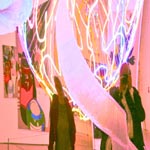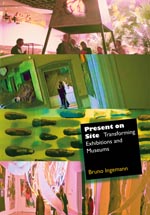
Visuals
The following links lead to a variety of videos, slideshows, images and sound, all of which are closely related to the paperback and online chapters. The contextual circumstances are briefly presented below and the paperback or the online chapters can be consulted for information about context.
introduction: page 2-6
 
If you remember, I’ll forget ... Fifty-nine objects from the Westergaard family were placed in the Holmbjerg family home and forty-four objects from the Holmbjerg’s were placed at the Westergaard’s.
Introduction: page 8-10
 
Ill. 2: Snow White in the courtyard of the Swedish Museum of National Antiquities. An art installation by Dror Feiler and Gunilla Sköld Deiler (2004). News clip from BBC.
Chapter 3: The human aspect in Ancient times: page 50
 
Ill. 3.1: The showcase with the two Vikings and items laid out like military weapons.
Chapter 4: The hidden exhibition: page 58
 
Ill. 4.1: To the left an illuminated wall stretches through the exhibition and is filled with texts, photographs and drawings as well as a timeline. To the right of the exhibition rooms is a row of showcases with well-lit objects organised according to strict aesthetic principles. Seeing the objects up close is possible here.
Chapter 5: Mise-en-scéne - One artist constructing... : p. 87
 
Ill. 5.6: The neon globe is fascinating because it mirrors the movements of a couple’s hands during intercourse. Intimacy is blown up in size in industrial neon light.
Chapter 6: The forced gazes: p. 107
 
Ill. 6.1: The room in the 1970’s bungalow is laden with heavy, comfortable furniture. The National Museum in Copenhagen, Denmark.
Chapter 6: The forced gazes: p. 111
 
Ill. 6.2: IKEA exhibition photographed on 13 June 2007 at 10:33 AM.
The title on the beam is “Welcome to our home”.
Chapter 9: Person-in-situation (1): p. 146-147
 
Ill. 9.1: Starting clockwise from the left are three screen dumps from Anne’s walk-video: famous inventor Jacob Ellehammer’s motorcycle, a placard with his aeroplane, the new airport in Copenhagen 1925 and a peek at the exhibition room. Screen dumps from the walk-video.
Chapter 10: Person-in-situation (2): p. 154
 
Ill. 10.1: Paint yourself, NOPIP, 1999. The three small men think the old pictures need some pepping up. Will they be discovered before making mischief?” Screen dumps from the walk-video.
Chapter 11: Person-in-situation (3): p. 164
 
Ill. 11.2: Some impressions from the Vala Runecast – showing nature and cultural symbole like horses, golden keys, opening doors and birds.
Chapter 13: Speaking places, places speaking: p. 190
 
Ill. 13.2: The finished panel from the installation with the panoramic photo of Rue de Caumartin. Inkjet print on 130 g heavyweight coated paper 38x178 cm, mounted on 50x200 cm MDF plate. Photographed on Wednesday 20 November 2002 from 13:06:50 to 13:07:20.
Chapter14: Invisibles - The exhibition design process: p. 207
  Ill. 14.2: From the Museum of Copenhagen 2010 exhibition: On the left the film Amager Common 1972 is being shown on the wall. In the middle are six black chipboards. Below the chipboard farthest to the right in the second row is a yellow poster, partially obscured by a little boy’s head, for the political meeting and panel debate. Ill. 14.2: From the Museum of Copenhagen 2010 exhibition: On the left the film Amager Common 1972 is being shown on the wall. In the middle are six black chipboards. Below the chipboard farthest to the right in the second row is a yellow poster, partially obscured by a little boy’s head, for the political meeting and panel debate.
Chapter14: Invisibles - The exhibition design process: p. 210
  Ill. 14.3: The NOAH exhibition »Some information about the earth we all live on« presented in the Copenhagen town hall in September 1970. The exhibition was later made into a travelling addition used for educational purposes in Danish schools. The exhibition shows that alternative experts have a strong voice. Ill. 14.3: The NOAH exhibition »Some information about the earth we all live on« presented in the Copenhagen town hall in September 1970. The exhibition was later made into a travelling addition used for educational purposes in Danish schools. The exhibition shows that alternative experts have a strong voice.
Chapter 14: Invisibles - The exhibition design process: p. 214-215
 
Ill. 14.4: The playful idea created for the book and for discussing various approaches to the development of ideas and design. Illustrations from the book.
Chapter 15: Provoked dialogue as reflection-in-action: p. 222
  Ill. 15.1: The final series of the poster exhibition. Produced to hang in public libraries, the original size of each poster is 100 x 70 cm. Ill. 15.1: The final series of the poster exhibition. Produced to hang in public libraries, the original size of each poster is 100 x 70 cm.
Chapter 16: The Journey - Design....: p. 349
  Ill. 16.2: The final poster for THE JOURNEY (REJSEN) exhibition. Ill. 16.2: The final poster for THE JOURNEY (REJSEN) exhibition.
Chapter 17: Journey of the soul: p. 260
 
Ill. 17.2: The first of Karale Andreassen’s original pencil drawings and the newly designed, digitally reversed picture manipulated to show the three observers on the left.
Chapter 18: Drifting sand: p. 277
  Ill. 18.4: An ‘Abundance’ sequence excerpt visualising the richness of nature using flashing lights in the life-giving water and the emergence of the cattle being herded. There was one, three, seven etc. Ill. 18.4: An ‘Abundance’ sequence excerpt visualising the richness of nature using flashing lights in the life-giving water and the emergence of the cattle being herded. There was one, three, seven etc.
Chapter 20: Museum: The three monkeys: p. 307
  This chapter examines how the see-no-evil, hear-no-evil, speak-no-evil monkeys are used in various communicative contexts and with quite different purposes. And I finally had to make a museum, albeit a small on-line one called, Museum: The three monkeys. This chapter examines how the see-no-evil, hear-no-evil, speak-no-evil monkeys are used in various communicative contexts and with quite different purposes. And I finally had to make a museum, albeit a small on-line one called, Museum: The three monkeys.
Chapter 23: Non-art and self creation: p. 246
  Ill. 23.3: YouTube, which contains this ‘new’ artwork, is an example of user-generated content with publication, creative effort and a creation outside professional practices. Ill. 23.3: YouTube, which contains this ‘new’ artwork, is an example of user-generated content with publication, creative effort and a creation outside professional practices.
|

![]()














 Ill. 14.2: From the Museum of Copenhagen 2010 exhibition: On the left the film Amager Common 1972 is being shown on the wall. In the middle are six black chipboards. Below the chipboard farthest to the right in the second row is a yellow poster, partially obscured by a little boy’s head, for the political meeting and panel debate.
Ill. 14.2: From the Museum of Copenhagen 2010 exhibition: On the left the film Amager Common 1972 is being shown on the wall. In the middle are six black chipboards. Below the chipboard farthest to the right in the second row is a yellow poster, partially obscured by a little boy’s head, for the political meeting and panel debate. Ill. 14.3: The NOAH exhibition »Some information about the earth we all live on« presented in the Copenhagen town hall in September 1970. The exhibition was later made into a travelling addition used for educational purposes in Danish schools. The exhibition shows that alternative experts have a strong voice.
Ill. 14.3: The NOAH exhibition »Some information about the earth we all live on« presented in the Copenhagen town hall in September 1970. The exhibition was later made into a travelling addition used for educational purposes in Danish schools. The exhibition shows that alternative experts have a strong voice. 
 Ill. 15.1: The final series of the poster exhibition. Produced to hang in public libraries, the original size of each poster is 100 x 70 cm.
Ill. 15.1: The final series of the poster exhibition. Produced to hang in public libraries, the original size of each poster is 100 x 70 cm.  Ill. 16.2: The final poster for THE JOURNEY (REJSEN) exhibition.
Ill. 16.2: The final poster for THE JOURNEY (REJSEN) exhibition.
 Ill. 18.4: An ‘Abundance’ sequence excerpt visualising the richness of nature using flashing lights in the life-giving water and the emergence of the cattle being herded. There was one, three, seven etc.
Ill. 18.4: An ‘Abundance’ sequence excerpt visualising the richness of nature using flashing lights in the life-giving water and the emergence of the cattle being herded. There was one, three, seven etc. This chapter examines how the see-no-evil, hear-no-evil, speak-no-evil monkeys are used in various communicative contexts and with quite different purposes. And I finally had to make a museum, albeit a small on-line one called, Museum: The three monkeys.
This chapter examines how the see-no-evil, hear-no-evil, speak-no-evil monkeys are used in various communicative contexts and with quite different purposes. And I finally had to make a museum, albeit a small on-line one called, Museum: The three monkeys. Ill. 23.3: YouTube, which contains this ‘new’ artwork, is an example of user-generated content with publication, creative effort and a creation outside professional practices.
Ill. 23.3: YouTube, which contains this ‘new’ artwork, is an example of user-generated content with publication, creative effort and a creation outside professional practices.